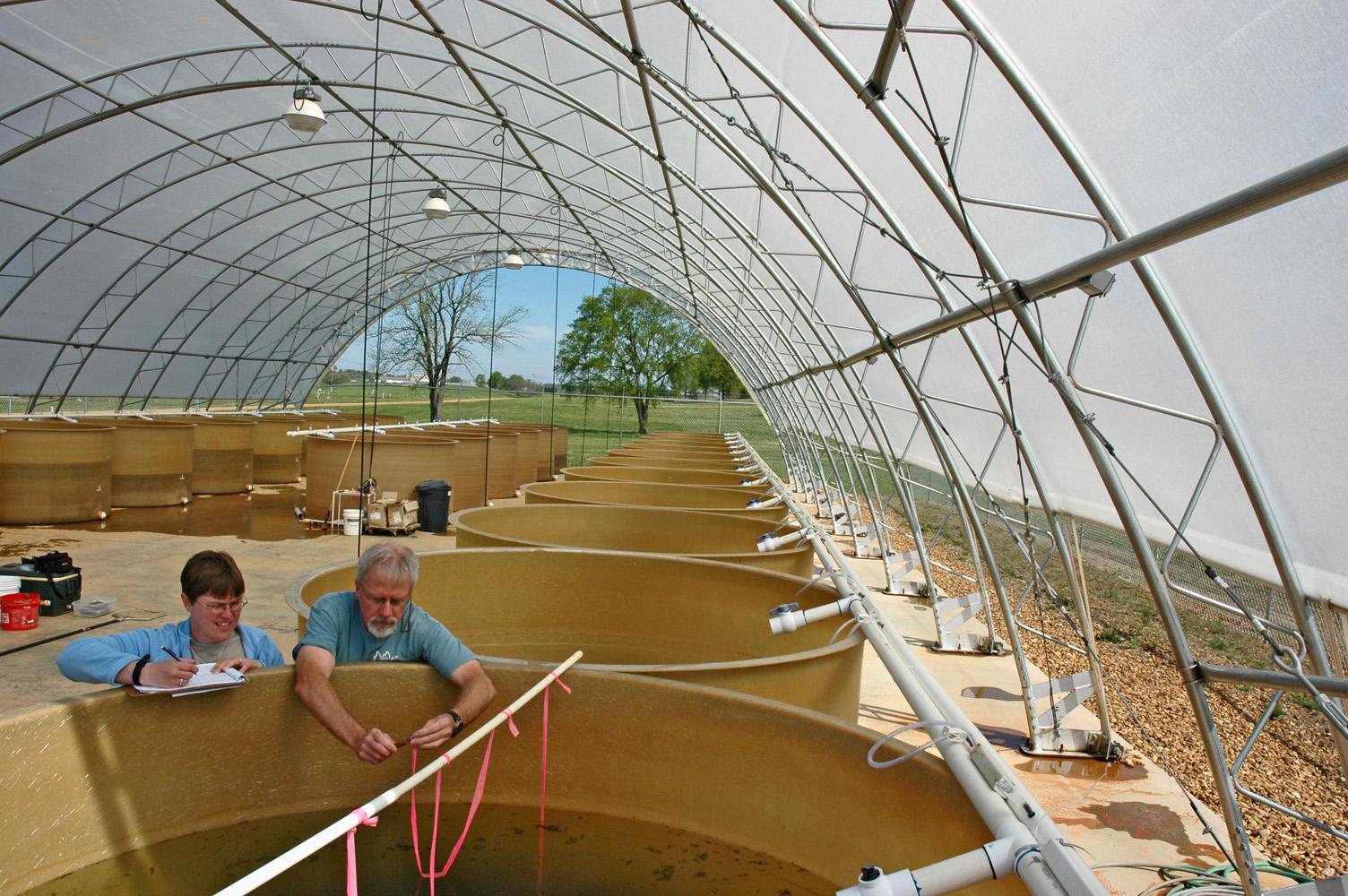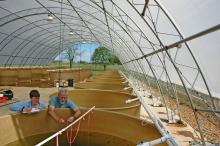Information Possibly Outdated
The information presented on this page was originally released on May 7, 2009. It may not be outdated, but please search our site for more current information. If you plan to quote or reference this information in a publication, please check with the Extension specialist or author before proceeding.
Mesocosm bridges study gap between lake and laboratory
By Patti Drapala
MSU Ag Communications
MISSISSIPPI STATE -- Aquatic researchers at Mississippi State University study the natural mechanisms at work in lake ecosystems so they can find better ways to manage habitats, but large bodies of water do not always make good laboratories.
Different lakes can have different sets of variables and environmental conditions that influence an outdoor study. Scientists at the Forest and Wildlife Research Center in MSU’s College of Forest Resources can account for these factors by conducting their experiments in a newly constructed mesocosm (pronounced mee-so-cah-zim) on MSU’s South Farm.
A mesocosm is an experimental system of large, drainable tanks that simulate real-life conditions and allow manipulation commonly done in a laboratory. The college’s Department of Wildlife and Fisheries built the mesocosm with funding from the Mississippi Agriculture and Forestry Experiment Station. Construction began in 2007, and the facility opened one year later.
“If we attempt to conduct an experiment in a large lake, we often lose control over the factors that can influence the outcome,” said aquatic ecologist Eric Dibble, MSU wildlife and fisheries professor. “If we conduct an experiment in the laboratory with test tubes, we often lose the realism of the lake system.”
The mesocosm gives researchers the control they need and the ability to incorporate realism into the experiment. It contains several fiberglass tanks, each holding up to 1,800 gallons of water. Researchers manipulate the plumbing, electricity and tank capacity to replicate different environmental conditions.
The facility has a porous, curved-in roof over the tanks to allow sunlight to enter. The roof also provides protection and security for experiments. Researchers drain the tanks into a secure lagoon that is treated with various control agents.
“Some of our research involves invasive plant species that cause problems for native plants and threaten food sources for fish, birds and animals,” Dibble said. “We incorporated a security system to prevent these invasives from escaping into the environment.”
Invasive plants are a major area of research in Mississippi because they are found in some of Mississippi’s river basins and waterways. Dibble has collaborated with MSU Geosystems Research Institute assistant professor John Madsen on the effect of invasive plants on aquatic ecosystems and the additional effect of managing these plants.
“A mesocosm can be used to address ecology and management of invasive plant species, the effect of nutrient loading from fertilizer runoff, toxicity of natural and synthetic chemicals, and manipulation of various food chains,” Madsen said.
In one current study at the mesocosm, Dibble is working with other researchers to investigate three control methods for invasive plants: herbicides, plant-eating fish and mechanical harvesting.
“We need to understand how each control method may affect the growth, diets and movement of fish that live in that habitat,” Dibble said. “We also need to know how these methods influence water quality and the microbial organisms living in the water.”
Another primary research opportunity the mesocosm presents is the reintroduction of rare, threatened and native fish species into Mississippi lakes and rivers. The mesocosm functions as a hatchery and gives researchers a reference point around which to develop good conservation strategies.
“We use the mesocosm to alter plant materials and manipulate microbial activity to see how these actions affect the ability of fish to survive and reproduce,” Dibble said. “Wildlife managers can use this information to improve natural habitats and keep them healthy.”
The presence of the mesocosm also enhances MSU’s ability to successfully obtain research grants investigating water quality and aquatic resources. Funding for such projects is becoming more readily available, an opportunity that MSU researchers can now pursue, said MSU Wildlife and Fisheries department head Bruce Leopold.
“Many water-related questions that need to be addressed through science-based research require controlled and replicated experiments that earthen ponds just do not allow,” Leopold said. “We needed this capability to be competitive for research grants.”
The mesocosm was initially begun to assist aquatics researchers in the MSU Wildlife and Fisheries Department, but faculty members within the Division of Agriculture, Forestry and Veterinary Medicine also can use the facility.
“Demand to use our mesocosm has grown so swiftly that we are now planning to expand the existing facility by adding more tanks,” Leopold said. “We also plan to design a facility with smaller tanks to examine water flow dynamics that can influence sedimentation and erosion.”


